Facebook users disseminated information in the social networks about the attack on the Olenivka prison in the Donetsk region where fighters from the Azov regiment are held captives. According to those publications, the Olenivka prison was bombed by Americans and Ukrainians with the US-made HIMARS missile system since they knew that the prisoners would have testified against the government of Ukraine. In particular, according to Zaza Davitaia, a journalist, and Tristan Tsitelashvili, a retired officer who was tried for treason, the prisoners were going to admit that Ukraine was planning military operations against Russia with the encouragement and the support of the US authorities. They also claimed that the Russians treat prisoners in full observance of the international conventions whilst Ukrainians torture the prisoners.
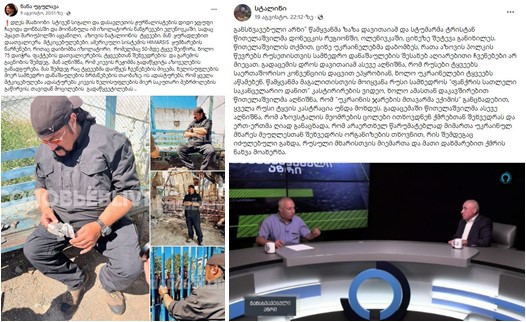
On 29 July 2022, a night-time attack was carried out on the Olenivka prison, situated in the temporarily Russian-controlled occupied territory. As a result, a building were Ukrainian prisoners of war were held captive was damaged and over 50 Ukrainian POWs were killed. Russia and Russia-supported separatists from Donetsk blamed the Armed Forces of Ukraine for the incident. The spokesperson of the Russian MoD, General Igor Konashenkov, stated that the Ukrainian regime organised this “bloody provocation” with the HIMARS missile system in order to make sure POWs do not testify against Ukraine. The General Staff of the Armed Forces of Ukraine released a statement in this regard to emphasise that the “bombardment is a military provocation organised by the Russian Federation and it is a typical false-flag operation which aims to hide war crimes, discredit the Armed Forces of Ukraine, hinder the supply of Western weapons to Ukraine and increase tensions among Ukrainian society.” The General Staff of the AFU also added that owing to high-precision weaponry, the AFU conducts precise attacks on Russia’s military facilities alone and it has not carried out artillery and missile strikes.”
CNN conducted an investigation about the incident. As part of the investigation, footage and photographs retrieved from the scene, as well as satellite imagery taken before and after attack together with the results of court forensics and arms expert studies, concluded that the Russian version of the event is very likely a fabrication.
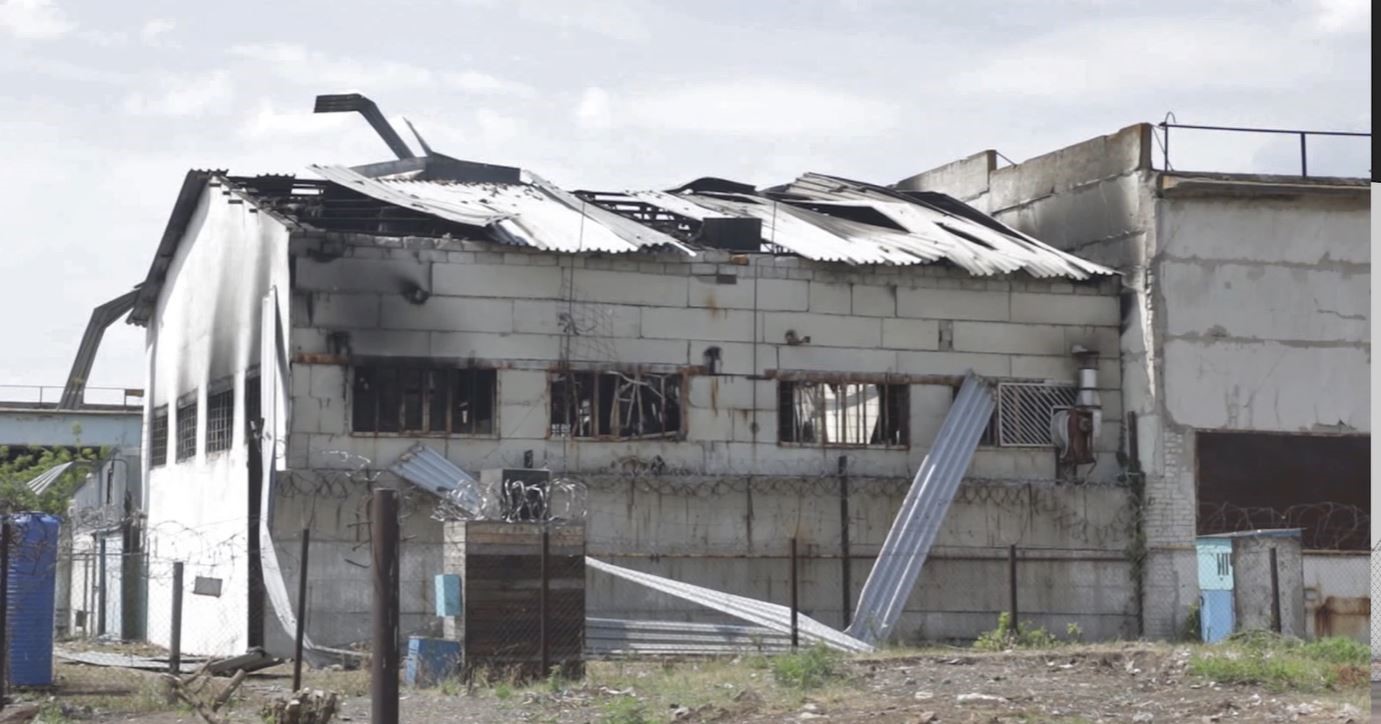
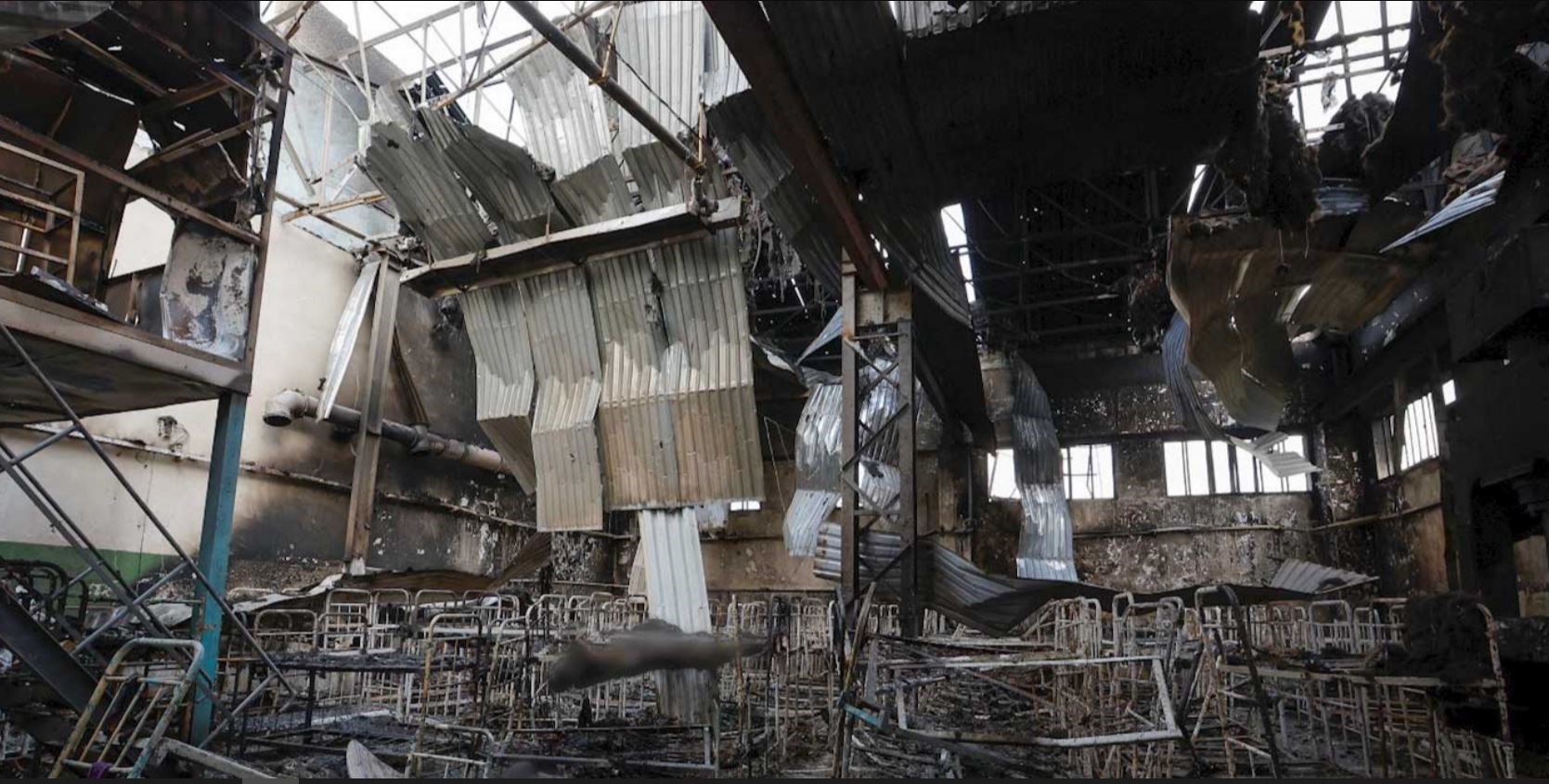
Source: CNN
The imagery taken after the strike shows the ruins of those compounds (warehouses) of the Olenivka prison where POWs were held. The imagery shows that the walls of a building and part of a roof survived the strike. According to the experts, the building would have been much more severely damaged in the case of a strike from the HIMARS missile system. In his interview with CNN, Weapons Expert Chris Cobb-Smith stated that the building, a warehouse with thin walls and a metal roof would not have been left standing by a HIMARS strike, adding: “If it was a guided multiple launch rocket system, you’d see craters, ceilings and walls shattered, bodies blown up. The experts also believe that it is more likely that source of the fire was within the building, since damage to the building and human bodies as well as placement of beds seem to be caused by an extensive and intensive fire rather than by a high explosive strike from the outside.”
In order to better understand the destructive power of the HIMARS rocket system, CNN provided satellite imagery which shows the results of a strike at a Russian weapons warehouse in Nova Kakhovka. The photograph in the right shows that the HIMARS strike completely destroyed the building in Nova Kakhovka. There are no signs of building walls as opposed to the Olenivka prison.
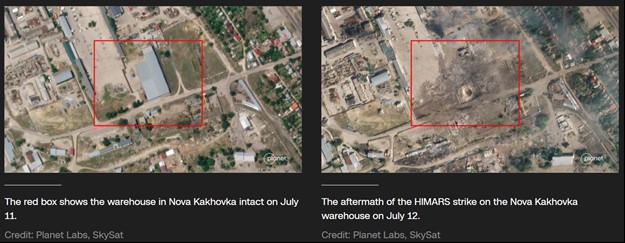
Location: Nova Kakhovka
Source: CNN
The satellite imagery disseminated by Maxar Technologies shows the warehouse of the Olenivka prison before and after the explosion. As shown in the photo on the right, building of the Olenivka warehouse is damaged, although the scale of damage is much less.
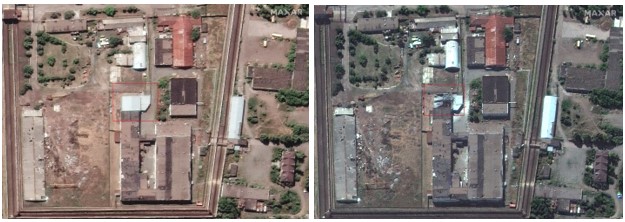
Location: Olenivka
Source: Maxar
At the same time, firing HIMARS rocket systems to strike a warehouse would have been irrational since HIMARS is a costly rocket system typically intended to hit long-distance targets. The damaged building, however, is located nearly 15 kilometres from the frontline.
Naturally, strikes from a missile-artillery system would have been heard. However, the mother of one of the POWs stated in her interview with CNN that the prisoners did not hear the rocket hit. Testimonies of family members of the POWs also indicate that a several days before the incident, nearly 200 Ukrainian POWs were moved from the main premises of Olenivka prison into the prison warehouse building. Among those POWs were those who posed danger to the Russian military by their attempts of rebellion. Therefore, it is virtually impossible that the strike on the prison was carried out by Ukraine with the HIMARS according to the investigation results.
After the strike on the Olenivka prison, the International Committee of the Red Cross requested access to the site, although Russia denied that request. On 4 August 2022, US National Security Council spokesman, John Kirby, citing intelligence reports, said Russia might be planting false evidence at the scene to deflect blame and therefore does not allow independent investigators to visit the site of the attack.
In addition, the publication includes disinformation that the Russians are treating prisoners in compliance with international conventions whilst Ukrainians are torturing the POWs. This groundless claim has been promoted multiple times during the war. The Russian side released several staged videos which showed that the Ukrainian POWs are in good conditions. However, there are numerous facts that prove the opposite.
On 29 June 2022, the UN Human Rights Monitoring Mission in Ukraine released a report saying that there are documented and verified allegations of unlawful killings, including summary executions of civilians in more than 30 settlements in the Kyiv, Chernihiv, Kharkiv and Sumy regions. The report also highlighted that arbitrary detention and the enforced disappearance of representatives of local authorities, journalists, civil society activists and other civilians by Russian armed forces and affiliated armed groups also take place. The mission further identified 23 cases of sexual violence, mostly attributable to the Russian armed forces. In addition, videos depicting insults, humiliation and ill-treatment toward Ukrainian POWs are also abundant. The report further underlined that there are videos showing that POWs are interrogated immediately after being captured and some of them have bruises on their bodies.
Furthermore, a 13 April 2022 report of Human Rights Watch, published under the auspices of the OSCE, expresses concern over the violation of the rights of POWs from both sides (Russian and Ukrainian) since representatives of the International Red Cross Committee are not allowed to visit the POWs.
More information about the issue can be found in previous FactCheck articles (link 1 and link 2).
Therefore, the claim of the Russian side that the Russians are treating Ukrainian POWs most humanely is merely the Kremlin’s propaganda message which is absolutely groundless. The claim that the Ukrainians blew up the Olenivka prison with a HIMARS strike is also ill-founded.
----------------------------------------------------
This article was produced as part of Facebook’s Fact-checking Programme. Given the rating, Facebook may impose different restrictions – click here for full information. For information on issuing a correction or to dispute a rating, please see here.







